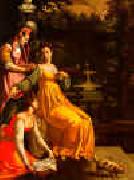 |
Jacopo da Empoli -- Click Here
|
|
1554-1640
Italian
Jacopo da Empoli Location
Italian painter and draughtsman. He lived and worked in Florence all his life, and he followed Santi di Tito in the return to the clarity of the Florentine High Renaissance. He absorbed the ideas of his more innovative contemporaries and became one of the most popular painters of altarpieces for churches in Florence and Tuscany. He was also a distinguished still-life painter and received many commissions from private patrons, among them the Medici. Empoli painting is distinguished by simple, lucid forms, strong colour and direct and clear interpretation of the subject. |
|
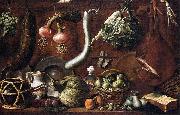 |
Jacopo Chimenti -- Click Here
|
|
(30 April 1551 - 30 September 1640) was an Italian late-mannerist painter.
Born in Florence as Jacopo Chimenti (Empoli being the birth place of his father), he worked mostly in his native city. He apprenticed under Maso da San Friano. Like his contemporary in Counter-Maniera (Counter-Mannerism), Santi di Tito, he moved into a style often more crisp, less contorted, and less crowded than mannerist predecessors like Vasari. He collaborated with Alessandro Tiarini in some projects. Among his pupils were Felice Ficherelli, Giovanni Battista Brazze (Il Bigio), Giovanni Battista Vanni, and Virgilio Zaballi.
In later years, the naturalism becomes less evident. The porcelain features of his figures accentuated the academic classical trends that restrained Florentine painting during the Baroque period. |
|
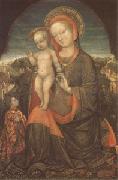 |
Jacopo Bellini -- Click Here
|
|
active in Florence 1423-Venice 1470 |
|
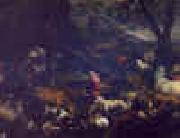 |
Jacopo Bassano -- Click Here
|
|
Italian
c1510-1592
Jacopo Bassano Gallery
He was apprenticed to his father, with whom he collaborated on the Nativity (1528; Valstagna, Vicenza, parish church). In the first half of the 1530s Jacopo trained in Venice with Bonifazio de Pitati, whose influence, with echoes of Titian, is evident in the Flight into Egypt (1534; Bassano del Grappa, Mus. Civ.). He continued to work in the family shop until his fathers death in 1539. His paintings from those years were mainly altarpieces for local churches; many show signs of collaboration. He also worked on public commissions, such as the three canvases on biblical subjects (1535-6; Bassano del Grappa, Mus. Civ.) for the Palazzo Communale, Bassano del Grappa, in which the narrative schemes learnt from Bonifazio are combined with a new naturalism. From 1535 he concentrated on fresco painting, executing, for example, the interior and exterior decoration (1536-7) of S Lucia di Tezze, Vicenza, which demonstrates the maturity of his technique. |
|
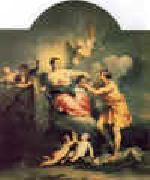 |
Jacopo Amigoni -- Click Here
|
|
1685-1752
Italian Jacopo Amigoni Galleries
He was born in Naples or Venice. Amigoni initially painted both mythological and religious scenes; but as the panoply of his patrons expanded northward, he began producing many parlour works depicting gods in sensuous languor or games. His style influenced Giuseppe Nogari. Among his pupils were Charles Joseph Flipart, Michelangelo Morlaiter, Pietro Antonio Novelli, Joseph Wagner, and Antonio Zucchi.
Starting in 1717, he is documented as working in Bavaria in the Castle of Nymphenburg (1719); in the castle of Schleissheim (1725-1729); and in the Benedictine abbey of Ottobeuren. He returned to Venice in 1726. His Arraignment of Paris hangs in the Villa Pisani at Stra. From 1730 to 1739 he worked in England, in Pown House, Moor Park and in the Theatre of Covent Garden. From there, he helped convince Canaletto to travel to England by telling him of the ample patronage available.
From his travel to Paris in 1736, he met the celebrated castrato named Farinelli. Later in Madrid, he was to paint a self-portrait with the singer and entourage. He also encountered the painting of François Lemoine and Boucher.
In 1739 he returned to Italy, perhaps to Naples and surely to Montecassino, in whose Abbey existed two canvases (destroyed during World War II). Until 1747, he travelled to Venice to paint for Sigismund Streit, for the Casa Savoia and other buildings of the city. In 1747 he left Italy and established himself in Madrid. There he became court painter to Ferdinand VI of Spain and director of the Royal Academy of Saint Fernando. He died in Madrid. |
|
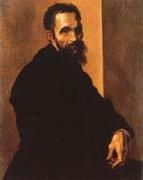 |
Jacopino del Conte -- Click Here
|
|
Italian Painter, ca.1510-1598
was an eminent Italian Mannerist painter, active in both Rome and Florence. A native of Florence, Jacopino del Conte was born the same year as another Florentine master Cecchino del Salviati (whom Conte outlived by 35 years) and, like Salviati and a number of other painters, he initially apprenticed with the influential painter and draftsman Andrea del Sarto. Conte's first frescoes, including Annunciation to Zachariah (1536), Preaching of Saint John the Baptist (1538), and Baptism of Christ (1541) were in the Florentine-supported Oratory of San Giovanni Decollato, located in Rome. The Preaching fresco was based on a drawing by Perin del Vaga. In 1547?C48, in collaboration with Siciolante da Sermoneta, Conte completed the fresco decoration of the chapel of San Remigio in San Luigi dei Francesi. In 1552, he painted another work for the San Giovanni Decollato Oratory, the altarpiece Deposition, whose designs are sometimes attributed to Daniele da Volterra. |
|
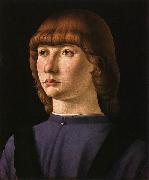 |
Jacometto Veneziano -- Click Here
|
|
Italy (Venezia 1472 -1497 ) - Painter |
|
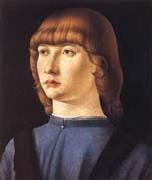 |
Jacometto -- Click Here
|
|
Italian Early Renaissance Painter, active 1472-1497 |
|
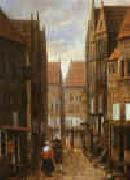 |
Jacobus Vrel -- Click Here
|
|
Dutch Baroque Era Painter, active ca.1654-1662
Dutch painter. Some 38 paintings, depicting domestic interiors, street scenes and a church interior, have been attributed to this enigmatic artist. Four copies after his works are possibly autograph; one drawing has also been ascribed to him. Over half of Vrel's paintings are signed or bear traces of signatures that were altered to read Johannes Vermeer or Pieter de Hooch, with whose paintings Vrel's work was often confused. Indeed, Theophile Thore discussed Vermeer as a townscape painter largely on the basis of works that were actually by Vrel. |
|
|
|
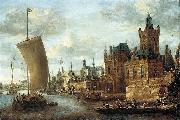 |
Jacobus Storck -- Click Here
|
|
(1641 - c.1700) was a Dutch Golden Age marine painter.
Storck was born and died in Amsterdam. According to Houbraken he was the brother of the marine painter Abraham Storck who painted views of the Rhine and inland ships, but who was not as gifted.
According to the RKD he was the second son of the marine painter Johannes Sturckenburgh, younger brother of the marine painter Johannes Storck and older brother of Abraham. Signed works by him are dated 1664-1687. He sometimes signed JA Storck, which since 1963 has been interpreted as a work by both Jacobus and Abraham together.
|
|
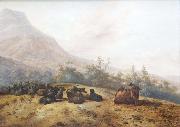 |
Jacobus Mancadan -- Click Here
|
|
(c. 1602, Minnertsga - 4 October 1680, Tjerkgaast) was a Dutch Golden Age painter mostly known for his pastoral landscapes.
|
|
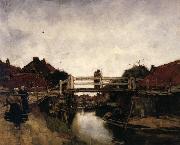 |
Jacobus Hendrikus Maris -- Click Here
|
|
Dutch Painter , 1837-1899
|
|
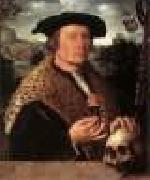 |
JACOBSZ, Dirck -- Click Here
|
|
Flemish Northern Renaissance Painter, ca.1497-1567
North Netherlandish painter, son of JACOB CORNELISZ. VAN OOSTSANEN. His birthdate is estimated from van Mander's claim that he died at the age of almost 70. His birthplace is unknown, but by about the age of three he was living in Amsterdam, where his father purchased a house in 1500. Dirck himself is documented in the city from 1546 until his burial. About 1550 he married Marritgen Gerritsdr., by whom he had two children, Maria Dircksdr. and Jacob Dircksz. War, also a painter. Dirck was trained by his father, probably around 1512, when Jan van Scorel was an apprentice. The two young artists may have remained friends, for in later years elements of Jan's mature, more Mannerist style can be seen in Dirck's paintings. Not only were Dirck's father and his brother, the little-known painter Cornelis Jacobsz. (d 1526-33), artists, his uncle Cornelis Buys I ( fl c. 1490-1524) |
|
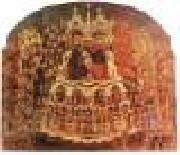 |
JACOBELLO DEL FIORE -- Click Here
|
|
Italian Early Renaissance Painter, 1370-1439 |
|
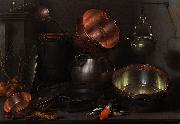 |
Jacob Willemsz. Delff -- Click Here
|
|
painted Allegory of the Four Elements. in 1600 |
|
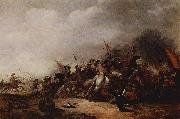 |
Jacob Weyer -- Click Here
|
|
painted Die Schlacht in 1630-1655
|
|
 |
Jacob Wessel -- Click Here
|
|
painted Portrait of Hieronim Florian Radziwiłł. in 1746 |
|
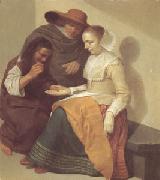 |
Jacob Van Velsen -- Click Here
|
|
delft before 1625-Amsterdam 1656 |
|
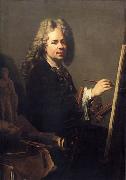 |
Jacob van Schuppen -- Click Here
|
|
Born in Fontainebleau, France, as the son of the painter-engraver Pieter van Schuppen, he worked in the Netherlands before moving to Vienna. He was taught to paint by his father and his uncle Nicolas de Largilliere.
In 1719 he was registered in Luneville, but he moved in the same year to Vienna where he became court painter. In 1725 he was appointed director of the Academy of Fine Arts Vienna, when it was refounded by Emperor Charles VI as the k.k. Hofakademie der Maler, Bildhauer und Baukunst (Imperial and Royal Court Academy of painters, sculptors and architecture). |
|
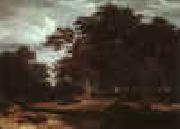 |
Jacob van Ruisdael -- Click Here
|
|
Dutch Baroque Era Painter, ca.1628-1682
Ruysdael's favorite subjects are simple woodland scenes, similar to those of Everdingen and Hobbema. He is especially noted as a painter of trees, and his rendering of foliage, particularly of oak leaf age, is characterized by the greatest spirit and precision. His views of distant cities, such as that of Haarlem in the possession of the marquess of Bute, and that of Katwijk in the Glasgow Corporation Galleries, clearly indicate the influence of Rembrandt.
He frequently painted coast-scenes and sea-pieces, but it is in his rendering of lonely forest glades that we find him at his best. The subjects of certain of his mountain scenes seem to be taken from Norway, and have led to the supposition that he had traveled in that country. We have, however, no record of such a journey, and the works in question are probably merely adaptations from the landscapes of Van Everdingen, whose manner he copied at one period. Only a single architectural subject from his brush is known--an admirable interior of the New Church, Amsterdam. The prevailing hue of his landscapes is a full rich green, which, however, has darkened with time, while a clear grey tone is characteristic of his seapieces. The art of Ruysdael, while it shows little of the scientific knowledge of later landscapists, is sensitive and poetic in sentiment, and direct and skillful in technique. Figures are sparingly introduced into his compositions, and such as occur are believed to be from the pencils of Adriaen van de Velde, Philip Wouwerman, and Jan Lingelbach.
Unlike the other great Dutch landscape painters, Ruysdael did not aim at a pictorial record of particular scenes, but he carefully thought out and arranged his compositions, introducing into them an infinite variety of subtle contrasts in the formation of the clouds, the plants and tree forms, and the play of light. He particularly excelled in the painting of cloudscapes which are spanned dome-like over the landscape, and determine the light and shade of the objects.
Goethe lauded him as a poet among painters, and his work shows some of the sensibilities the Romantics would later celebrate. |
|
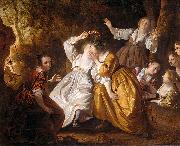 |
Jacob van Loo -- Click Here
|
|
(1614 - 26 November 1670) was a Flemish painter who is considered one of the Dutch Masters of the 17th Century. Van Loo is known for his conversational groupings, his use of a subtle color palette and his nudes. He was the founder of the Van Loo family of painters.
Van Loo was born in Sluis, Zeeland, in the Dutch Republic. Some sources have spe,culated that his father, Jan van Loo, may have been a notary, but more often his father is described as a painter from whom Jacob van Loo received his early training. Little is known of Van Loo's early history due to the destruction of the city archives in Sluis during World War II.
His early influences included Thomas de Keyser and Jacob Adriaensz Backer. In 1642, van Loo moved to Amsterdam, where his contemporaries included Rembrandt, Frans Hals, and Bartholomeus van der Helst. In 1643 he married the sister of the painter, Martinus Lengele. The couple had six children. They lived on Rozengracht in the Jordaan district of Amsterdam. Eglon van der Neer became one of his pupils. In 1660, Van Loo fled the city after fatally stabbing someone during an altercation at an inn. He was sentenced to death in absentia which forever prevented his return to Holland. Van Loo settled in Paris, where he was admitted to the Academie de peinture et de sculpture. He died in Paris in 1670.
Van Loo's work was done in the Baroque style that had originated in Rome. The Baroque style was popular throughout Europe during this period. Van Loo was a major influence on Johannes Vermeer as can be seen in Vermeer's painting, Diana and Her Companions.
Van Loo painted many portraits. Among his subjects were Johan Huydecoper van Maarssenveen; his sister, Leonara Huydecoper, who was married to Jan J. Hinlopen; Joan Ortt, who was later involved with Antoinette Bourignon; and his wife.
Jacob van Loo's son, Louis Abraham van Loo, was also a painter, as were his grandsons, Jean-Baptiste van Loo and Charles-Andra van Loo.
|
|
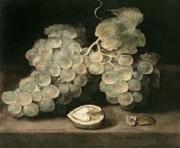 |
Jacob van Es -- Click Here
|
|
Flemish Baroque Era Painter, 1596-1666
was a Flemish Baroque still life painter active in Antwerp. His restrained ontbijt (breakfast) pieces share many similarities to contemporaries Osias Beert and Clara Peeters, and typically show various foods on a sharply angled table in the foreground. |
|
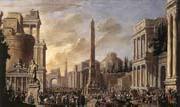 |
Jacob van der Ulft -- Click Here
|
|
Dutch Baroque Era Painter, 1627-1689 |
|
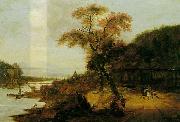 |
Jacob van der Does -- Click Here
|
|
(4 March 1623, Amsterdam - buried 17 November 1673, Sloten) was a Dutch Golden Age landscape painter.
Van der Does was the son of the secretary of the Amsterdam city council. He was more attracted to the arts than to note-taking, and went to study drawing with Claes Corneliszoon Moeyaert. He left at 21 to go to France, and from there on foot to Italy. In Rome he joined the Bentvueghels and was dubbed Tamboer, which means drummerboy, since he was somewhat short and had been meant for the military life. He studied with Pieter van Laer (Bamboots). When he eventually returned North, he settled in The Hague where he married Margaretha Boortens and got 4 sons and a daughter. His wife died in 1661. Houbraken liked his natural style of painting, and especially his way of painting sheep was very admirable.His wife's sister was Maria Boortens, and they both were good artists themselves. All three of them made drawings for the album of the wealthy Hague diplomat Cornelis de Glarges in 1659. Through Maria Boortens, Jacob van der Does was connected to Jacob van Campen and Adriaen van Nieulandt the younger. He became involved in the Guild of St. Luke in The Hague. He was one of the founders of the Confrerie Pictura in 1656. His pupils were Theodor Bernoille, Marcus de Bye, Gamaliel Day, Alexander Havelaer, Anthony Schinckels, and his sons Jacob II and Simon van der Does. |
|
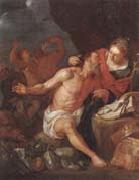 |
Jacob Toorenvliet -- Click Here
|
|
Dutch Baroque Era Painter ,
Leiden circa 1635-1719
|
|
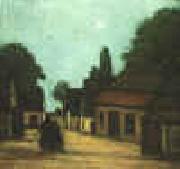 |
Jacob Smits -- Click Here
|
|
1856-1928
German Jacob Smits Gallery |
|
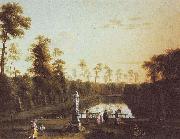 |
Jacob Philipp Hackert -- Click Here
|
|
(September 15, 1737 - April 28, 1807) was a landscape painter from Brandenburg, who did most of his work in Italy.
Hackert was born in 1737 in Prenzlau in the Margraviate of Brandenburg (now in Germany). He trained with his father Philipp (a portraitist and painter of animals) and his uncle, before going to the Akademie der Kenste in Berlin in 1758. Later he traveled to Swedish Pomerania and Stockholm, where he painted murals.
He spent from 1765 to 1768 in Paris, with the Swiss Artist, Balthasar Anton Dunker, where he focused on painting in gouache. He met and was inspired by Claude Joseph Vernet, who was already famous as a painter of landscapes and seascapes, and the German engraver Johann Georg Wille.
In 1768 Hackert left Paris with his brother Georg, and went to Italy, basing himself mainly in Rome and Naples, where he produced many works for Sir William Hamilton. He travelled all over Italy, gaining a reputation as a talented landscape painter.
In 1786 he went to work for Ferdinand I of the Two Sicilies in Naples. He advised on the creation of a painting restoration laboratory at the Museo di Capodimonte, and supervised the transfer of the Farnese collections from Rome to Naples. By this time he had an international reputation, and won commissions from empress Catherine II of Russia, king Louis XVI of France and others. When Goethe visited Naples in 1786, he and Hackert became friends. |
|
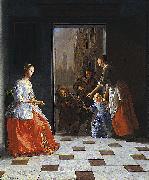 |
Jacob Ochtervelt -- Click Here
|
|
(1634, Rotterdam - 1682, Amsterdam), was a Dutch Golden Age painter.
According to the RKD he was active in Haarlem where he was a student of Nicolaes Pietersz Berchem and later he moved back to Rotterdam (1655-1672) where he was a pupil of Ludolf de Jongh. After the rampjaar he moved to Amsterdam |
|
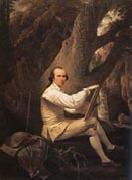 |
Jacob More -- Click Here
|
|
1740-93
Scottish painter, active in Italy. The son of an Edinburgh merchant, he was first apprenticed to a goldsmith and then, from 1766, to the Norie family of house-painters. In the 1760s he produced numerous sketches of the Scottish Lowlands (examples Edinburgh, N.G.), and in 1769 he designed and executed stage sets at the Theatre Royal, Edinburgh, for the first productions after the legalizing of the theatre in Scotland. More's Edinburgh period culminated in a series of oil paintings of the Falls of the River Clyde, three of which are in public collections: Corra Linn (Edinburgh, N.G.), Stonebyres Linn (London, Tate) and Bonnington Linn (Cambridge, Fitzwilliam). These paintings are regarded as the first serious artistic interpretations of the Scottish landscape, depictions by previous artists having been essentially topographical in character. More took a set of three of them to the Society of Artists Exhibition in London in 1771, at which he gained widespread recognition and the personal encouragement of Sir Joshua Reynolds. |
|
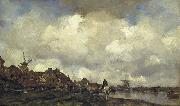 |
Jacob Maris -- Click Here
|
|
(August 25, 1837, The Hague - August 7, 1899, Karlsbad) was a Dutch painter, who with his brothers Willem and Matthijs belonged to what has come to be known as the Hague School of painters.
Maris studied at the Antwerp Academy, and subsequently in Hubertus van Hove's studio during a stay in Paris from 1865 till 1871. He returned to Holland when the Franco-Prussian War broke out, and died there in August 1899. Though he painted, especially in early life, domestic scenes and interiors invested with deeply sympathetic feeling, it is as a landscape painter that Maris excelled. He was the painter of bridges and windmills, of old quays, massive towers, and level banks; even more was he the painter of water, and misty skies, and chasing clouds. In all his works, whether in water or oil color, and in his etchings, the subject is always subordinate to the effect. His art is suggestive rather than decorative, and his force does not seem to depend on any preconceived method, such as a synthetical treatment of form or gradations of tone. And yet, though his means appear so simple, the artist's mind seems to communicate with the spectator's by directness of pictorial instinct, and we have only to observe the admirable balance of composition and truthful perspective to understand the sure knowledge of his business that underlies such purely impressionist handling.
|
|
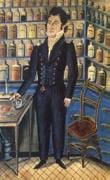 |
Jacob Maentel -- Click Here
|
|
American physician and watercolor portraits painter,1763-1863 |
|
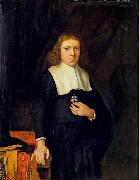 |
Jacob Levecq -- Click Here
|
|
(1634 - 1675), was a Dutch Golden Age painter trained by Rembrandt.
According to Houbraken, who was his pupil during the last 9 months of his life, he had been trained by Rembrandt, but inherited a sum of money when his parents died, that he used to take care of himself, his two unmarried sisters and a blind half-brother. Houbraken could not recall much of his painting style, since he had been mostly sick while he was living in the house, and he no longer painted actively. In his younger years Levecq travelled to Paris and Sedan where he painted portraits, and on his return to Dordrecht became a portrait painter in the manner of Jan de Baen. When he died, Houbraken inherited a third of his prints, but regretted the fact that as a young boy with little experience in such matters, he only chose prints by Lucas van Leyden and Albert Durer, and had left the French prints for others, and so was very glad that he had received one anyway by Charles le Brun. |
|
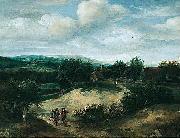 |
Jacob Koninck -- Click Here
|
|
(c. 1615, Amsterdam - c. 1695, Copenhagen), was a Dutch Golden Age landscape painter.
According to Houbraken he lent his books on perspective to Johannes Verkolje, who became better than he was at perspective drawing.He was a disciple of Adriaen van de Velde who became a popular painter in Copenhagen where he painted for the court of Christian V of Denmark.
According to the RKD he was the uncle of Salomon Koninck, a pupil of David Colijns and became the teacher of his son Jacob II and his younger brother Philips Koninck.He was in Dordrecht from 1633-1636, Rotterdam from 1637-1645, The Hague from 1647-1651, back in Amsterdam in 1658 (when he probably lent young Verkolje his perspective books), and moved to Denmark in 1676.
|
|
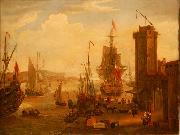 |
Jacob Knyff -- Click Here
|
|
(January 1, 1639, Haarlem - 1681, London), was a Dutch Golden Age painter.
According to Houbraken he was the teacher of Johannes Gottlieb Glauber in Paris in 1671, where he attended the funeral of Nicolaes Berchem II on January 4, 1672. he was probably the son of the painter Wouter Knijff, and is known for painting landscapes and seascapes |
|
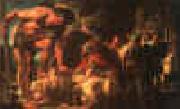 |
Jacob Jordaens -- Click Here
|
|
Flemish Baroque Era Painter, 1593-1678
Jacob Jordeans was born on May 19, 1593, the first of eleven children, to the wealthy linen merchant Jacob Jordaens Sr. and Barbara van Wolschaten in Antwerp. Little is known about Jordaens's early education. It can be assumed that he received the advantages of the education usually provided for children of his social class. This assumption is supported by his clear handwriting, his competence in French and in his knowledge of mythology. Jordaens familiarity with biblical subjects is evident in his many religious paintings, and his personal interaction with the Bible was strengthened by his later conversion from Catholicism to Protestantism. Like Rubens, he studied under Adam van Noort, who was his only teacher. During this time Jordaens lived in Van Noort's house and became very close to the rest of the family. After eight years of training with Van Noort, he enrolled in the Guild of St. Luke as a "waterscilder", or watercolor artist. This medium was often used for preparing tapestry cartoons in the seventeenth century. although examples of his earliest watercolor works are no longer extant. In the same year as his entry into the guild, 1616, he married his teacher's eldest daughter, Anna Catharina van Noort, with whom he had three children. In 1618, Jordaens bought a house in Hoogstraat (the area in Antwerp that he grew up in). He would then later buy the adjoining house to expand his household and workspace in 1639, mimicking Rubens's house built two decades earlier. He lived and worked here until his death in 1678.
Jordaens never made the traditional trip to Italy to study classical and Renaissance art. Despite this, he made many efforts to study prints or works of Italian masters available in northern Europe. For example, Jordaens is known to have studied Titian, Veronese, Caravaggio, and Bassano, either through prints, copies or originals (such as Caravaggio's Madonna of the Rosary). His work, however, betrays local traditions, especially the genre traditions of Pieter Bruegel the Elder, in honestly depicting Flemish life with authenticity and showing common people in the act of celebratory expressions of life. His commissions frequently came from wealthy local Flemish patrons and clergy, although later in his career he worked for courts and governments across Europe. Besides a large output of monumental oil paintings he was a prolific tapestry designer, a career that reflects his early training as a "watercolor" painter.
Jordaens' importance can also be seen by his number of pupils; the Guild of St. Luke records fifteen official pupils from 1621 to 1667, but six others were recorded as pupils in court documents and not the Guild records, so it is probable that he had more students than officially recorded. Among them were his cousin and his son Jacob. Like Rubens and other artists at that time, Jordaens' studio relied on his assistants and pupils in the production of his paintings. Not many of these pupils went on to fame themselves,however a position in Jordaens's studio was highly desirable for young artists from across Europe. |
|
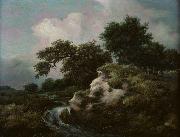 |
Jacob Isaacksz. van Ruisdael -- Click Here
|
|
painted Landscape with Dune and Small Waterfall in 1646 |
|
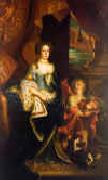 |
Jacob Huysmans -- Click Here
|
|
1633-1696
Flemish
Jacob Huysmans Gallery
Jacob Huysmans (c.1633?C1696), was a Flemish portrait painter. He moved to England during the reign of Charles II where he became one of the fashionable painters of the court. His chief portraits are those of Izaak Walton and Catherine of Braganza, Charles II's wife (both displayed on the National Gallery, London).
He was a pupil of Gilles Backereel and Frans Wouters and came over to England from - presumably - Antwerp. His first works were pastiches of work from Anthony van Dyck. As a Roman Catholic he was favoured by Catharine of Braganza. When Samuel Pepys visited his workshop in Westminster on 26 August 1664, he described him as a 'picture-drawer ... which is said to exceed Lilly (Lely). Huysmans's most important portrait of Catharine of Braganza, Queen Catharine as a Shepherdess (c. 1664; Brit. Royal Col.), was one of the pictures Pepys saw on that occasion. Painting his subjects as sheperdesses with clothing embellished with embroidery and jewellery were typical of his style.
|
|
 |
Jacob Heinrich Elbfas -- Click Here
|
|
Swedish, born circa 1600-1664,was a portrait painter Elbfas was educated in Strasbourg in a tradition drawing back to Renaissance portraits. He established himself in Sweden from 1622 and from 1628 in Stockholm where he became a guild master. During the period 1634-1640 he worked as a court painter for Queen Maria Eleonora. His was frequently employed by the Swedish nobility and his influence on Swedish art was considerable until a new generation of artists were invited by Queen Christina during the 1640s. |
|
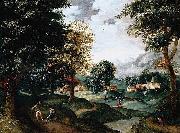 |
Jacob Grimmer -- Click Here
|
|
(ca. 1526-1590) was a Flemish Renaissance landscape painter.
Grimmer was born and died in Antwerp. According to Karel van Mander he first learned to paint landscapes from Matthys Cock and later from Christiaen Queburgh, both of Antwerp. He was a very skilled painter of houses, sky, and foreground views. He was a member of the Guild of St. Luke who was active as a rederijker and acted in many plays.
According to the RKD his earliest dated work is from 1546 and his latest dated work was 1589. Most of his works are landscapes and he worked together with Gillis Mostaert. Abel Grimmer was his son and pupil.
|
|
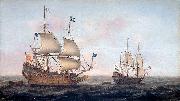 |
Jacob Gerritz. Loeff, Monogrammist JGL -- Click Here
|
|
Alternative names Jacob Gerritz. Loeff, Monogrammist JGL
Description Dutch painter
Date of birth/death c. 1606-1607 after 1670
|
|
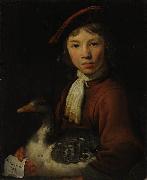 |
Jacob Gerritsz. Cuyp -- Click Here
|
|
was a portrait and landscape painter. He was born and died in Dordrecht, and was the half-brother of Benjamin Gerritsz Cuyp and the father of the much more famous Aelbert Cuyp.
According to Houbraken, he helped the painters Jacques de Claeuw, Isaac van Hasselt, and Cornelis Tegelberg set up a Guild of Saint Luke in Dordrecht in 1642.
|
|
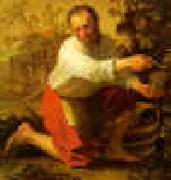 |
Jacob Gerritsz Cuyp -- Click Here
|
|
1594-1652
Dutch
Jacob Gerritsz Cuyp Locations
Painter and draughtsman. Probably taught by his father, he entered the Guild of St Luke in Dordrecht in 1617, the same year that he executed an important commission to portray the masters of the Holland Mint (Dordrecht, Mus. van Gijn). He was the Guild bookkeeper in 1629, 1633, 1637 and 1641 and, according to Houbraken, led Dordrecht fine painters in their separation from the Guild in 1642. Jacob married Aertken van Cooten from Utrecht in 1618; his only child, (3) Aelbert Cuyp, was born two years later. |
|
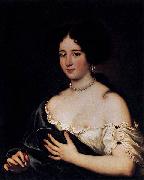 |
Jacob Ferdinand Voet -- Click Here
|
|
(c. 1639 - c. 1689/1700) was a Flemish Baroque portrait painter.
According to the Netherlands Institute for Art History (RKD) he was born at Antwerp as the son of the painter Elias Voet.[1] He travelled to Rome in 1679-1680, Milan in 1680, Florence in 1681, Turin in 1682-1684, and returned to Antwerp in 1684. While in Rome he lived with the painter-engraver Cornelis Bloemaert until he was banned for his portraits of women portrayed with unseemly decollet, whereupon they left Rome together. He undertook a journey to Paris in 1686 where he became court painter until he died there.He is registered as a painter of miniature portraits.
According to Houbraken, he made his return journey to Antwerp from Turin in the company of Jan van Bunnik, who he had already met in Rome in the company of Cornelis Bloemaert. From Turin they set out for Lyons, where they met Adriaen van der Cabel, Peter van Bloemen, and Gillis Wenix. They set off for Paris in the company of a third painter who was a good painter of "bataljes" or battle scenes. Houbraken reports that this was Jacob, Jan van Bunnik's brother, but had not mentioned him earlier in his Jan van Bunnik biography. The RKD makes no mention of a Jacob van Bunnik. |
|
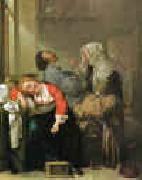 |
Jacob Duck -- Click Here
|
|
1600-1667
Dutch
Jacob Duck Location
Dutch painter and etcher. He was long confused with Jan le Ducq (1629/30-76). In 1621 he was listed as an apprentice portrait painter in the records of the Utrecht Guild of St Luke. His teacher was probably Joost Cornelisz. Droochsloot (1586-1666). The St Job Hospital in Utrecht acquired a Musical Company by him in 1629. By 1630-32 he was a master in the guild. Like Pieter Codde, he painted guardroom scenes (kortegaerdjes), for example Soldiers Arming Themselves (c. 1635; New York, H. Shickman Gal., see 1984 exh. cat., no. 36) or the Hoard of Booty (Paris, Louvre), in which the figures and their interactions are apparently full of underlying symbolic meaning. He also painted merry companies (e.g. c. 1630; Names, Mus. B.-A.) and domestic activities, such as Woman Ironing (Utrecht, Cent. Mus.), employing motifs perhaps symbolic of domestic virtue. He placed his figures in high, bare interiors in which the deep local colours of the foreground stand out well against the cool, greyish-brown background. Only a few of his etchings are known (Hollstein, Dut. & Flem., vi, pp. 9-11), depicting figures in contemporary dress, for example Young Gentleman with Broad Hat and Cloak (Hollstein, no. 10) or Virgin and Child with Magi (nos 1-4). Between 1631 and 1649 Duck presence is documented in Utrecht, Haarlem and Wijk bij Duurstede. Afterwards, and probably by 1656, he was living in The Hague. He was buried at the monastery of St Mary Magdalene in Utrecht. |
|
 |
Jacob de Wit -- Click Here
|
|
(19 December 1695 - 12 November 1754) was a Dutch artist and interior decorator who painted many religious scenes.
De Wit was born in Amsterdam, and became famous for his door and ceiling paintings. He lived on the Keizersgracht in Amsterdam, and many of the buildings on the Keizersgracht still have door or ceiling paintings done by him. Since many of the families who lived in Amsterdam in those days had country villas, de Wit also painted in houses in the fashionable areas of Haarlem and the Vecht river.
According to the RKD he was the pupil of Albert Spiers in Amsterdam and Jacob van Hal in Antwerp where he became a member of the Guild of St. Luke in 1714. His pupils were Jan de Groot (painter from The Hague), Dionys van Nijmegen, Jan Punt, Pieter Tanje, and the brothers Frans and Jacob Xavery. De Wit died in Amsterdam in 1754.Tako Hajo Jelgersma was his follower. |
|
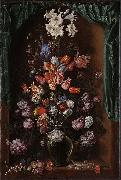 |
Jacob de Gheyn II -- Click Here
|
|
Jacob de Gheyn II (also Jacques de Gheyn II) (c. 1565, Antwerp - March 29, 1629, The Hague) was a Dutch painter and engraver, whose work shows the transition from Northern Mannerism to Dutch realism over the course of his career.
|
|
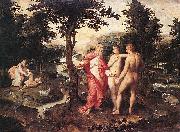 |
Jacob de Backer -- Click Here
|
|
(c. 1555 - c. 1585) was a Flemish Mannerist painter and draughtsman active in Antwerp between about 1571 and 1585.
According to the RKD he was born in Antwerp in c.1540/45 and died there c.1591-1600.De Backer was abandoned by his father as a young boy. Carel van Mander reports that the artist studied with Antonio van Palermo and Hendrik van Steenwijk I, but that Palermo worked him so hard that the young de Backer died in the arms of his master's daughter at the age of thirty.
Although the artist painted in the high mannerist style of Giorgio Vasari, he never appeared to travel to Italy. A series of the "Seven Deadly Sins", however, was bought in Antwerp by Alessandro Farnese's secretary Cosimo Masi in 1594 and taken to Italy.These paintings are now in the Museo di Capodimonte in Naples. Other attributable works include a Last Judgment triptych by him or his studio for Christophe Plantin's tomb in the Antwerp Cathedral (c. 1589; illustrated right), and an Allegory of the Three Ages of Man in the Hermitage Museum, St. Petersburg.
He is not to be confused with the Dutch Golden Age painter Jacob Adriaensz Backer from
|
|
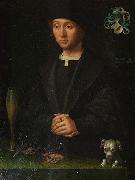 |
Jacob Claesz van Utrecht -- Click Here
|
|
also named by his signature Jacobus Traiectensis (born c. 1479 - dead after 1525) was a Flemish early Renaissance painter who worked in Antwerp and Lebeck.
Jacob van Utrecht's life is still very much in the dark. Research on this important Flemish artist did not start before the end of 19th century. He was probably born in Utrecht, although it is not certain. It is assumed that he became a citizen of Antwerp around 1500 and he is recorded as a "free master craftsman" of the Guild of St Luke there from 1506 to 1512.
From 1519 to 1525 he is recorded as a member of the Leonardsbruderschaft ("Leonard's Brotherhood"), a religious confraternity of merchants in Lebeck among whose ranks the leaders of the Protestant Reformation in the 1530s could be found.
From then on no traces of his life have been found.
|
|
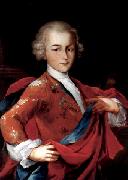 |
Jacob Carl Stauder -- Click Here
|
|
(1694 -1756 ) - Painter
|
|
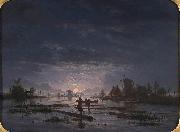 |
Jacob Abels -- Click Here
|
|
(1803 - 1866) was a Dutch painter.
He was born in Amsterdam in 1803, and was instructed in art by Jan van Ravenswaay, the animal painter. In 1826 he visited Germany, and on his return settled at the Hague. He distinguished himself especially in painting moonlight landscapes. The Museum at Haarlem has works by him. Abels died at Abcoude in 1866.
|
|
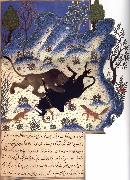 |
Jackals Kalila and Dimna -- Click Here
|
|
the period of 1465-1535
|
|
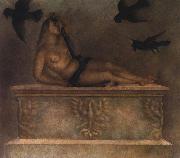 |
Jacek Mierzejewski -- Click Here
|
|
painted Polonia in 1915 |
|
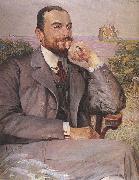 |
Jacek Malczewski -- Click Here
|
|
(15 July 1854 in Radom - 8 October 1929 in Krakow) was one of the most famous painters of Polish Symbolism. In his creativity he successfully joins the predominant style of his times with motifs of Polish martyrdom.
|
|
|
|
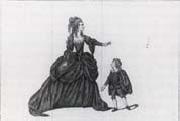 |
J.Thornthwaite -- Click Here
|
|
British.fl.late eighteenth century |
|
|
|
|
|
|
|
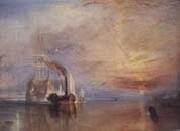 |
J.M.W.Turner -- Click Here
|
|
English Romantic Painter, 1775-1851, British land- and seascape artist. Born in London the son of a barber, Turner was precociously talented. He entered the RA Schools in 1789, had a drawing exhibited at the academy in 1790, and was elected a full academician in 1802. He became professor of perspective in 1807. A prolific artist of amazing range of subject and style, he began work in water-colours, quickly founding both a reputation and a fortune, which made him independent of changing public taste. His work was not appreciated by everyone, but his supporters included Thomas Lawrence, John Ruskin, and the earl of Egremont. He died in eccentric obscurity under a false name. |
|
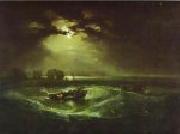 |
J.M.W. Turner -- Click Here
|
|
English Romantic Painter, 1775-1851 landscape master
landscape master .British painter and printmaker. He dominated British landscape painting throughout the first half of the 19th century. He established a reputation in the Royal Academy, London, first as a topographical watercolourist and then within a few years as a painter of Sublime and historical landscapes. |
|
|
|
|
|
|
|
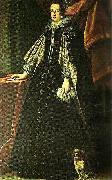 |
j. sustermans -- Click Here
|
|
1640
florence, palazzo pitti
|
|
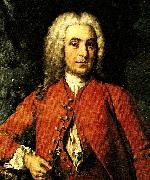 |
j. h. scheffel -- Click Here
|
|
Wismar 1690 - Västerås 1786
J.H. Scheffel kom från en borgasläkt i Wismar, en nordtysk stad som på 1600-talets införlivats med Sverige. Om Scheffels läroår vet man ingenting utöver uppgiften i en gammal biografi att han studerade till målare i Berlin, Paris och Brabant.
Scheffel dök upp i Stockholm år 1723. Uppenbarligen samarbetade han först med David von Krafft. Efter dennes död 1724 grundade Scheffel, då redan fullärd porträttör, sin egen atelj??. Ett av de första uppdragen, porträttet av borgmästare Bergstedts unga dotter, ledde till ett lyckligt och av en riklig hemgift åtföljt äktenskap med fröken Bergstedt.
Scheffel samlade redan tidigt kring sig en trogen kundkrets bland adeln och det förmögna borgarskapet. Han behöll sin framgångsrika position från 1720-talet till 1760-talet. Någon ledande hovmålare eller mest gynnad societetsmålare i Stockholm var Scheffel aldrig. Hans stadiga popularitet som pålitlig och kompetent porträttmålare rubbades emellertid inte av modets växlingar, ty han hade förmågan att smidigt följa de nya strömningarna utan att pruta på sin karga och förnuftiga konstnärliga egenart. Scheffels porträtt visar sällan prov på pretentiösa barockgester eller affekterad romantisk tillgjordhet. Hans personåtergivning var utfunderad och konstaterande. I hans digra produktion ingår stela rutinarbeten, men i bästa fall är hans målningar karaktärsstudier som bygger på en stark vision. Hans målningsteknik var kompetent men anspråkslös: i helheten fäster man uppmärksamhet vid mänskobilden, inte vid utförandet.
När Scheffel i 75-årsåldern som pensionerad drog sig tillbaka för att tillbringa tiden med sin familj var han en rask och förmögen gammal herre. Han uppnådde den för tiden ovanligt höga åldern av 91 år, enligt dottersonen till följd av sitt glada och jämna humör, sina ordentliga levnadsvanor och en till åldern anpassad flit och motion .
|
|
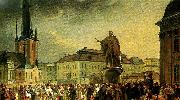 |
j. g. sandberg -- Click Here
|
|
Johan Gustaf Sandberg, född 1782, död 1854, var målare; han var professor i teckning vid Konstakademien från 1828, och direktör där 1845?C1853.
Sandberg ägnade sig främst åt historiemåleri, med motiv ur nordisk mytologi och svensk historia. Hans främsta verk inom detta område är kalkmålningarna över Gustav Vasa i Uppsala domkyrka. Han målade också en mängd porträtt.
Efter akademiska studier i Åbo med början 1783, och Uppsala, dit han flyttade 1788, blev han filosofie magister 1791. Han blev 1792 extra ordinarie kanslist i akademiska kansliet. Juris utriusque kandidat blev han 1792 och kort därefter docent vid juridiska fakulteten, blev juris licentiat 1800 och utnämndes 1807 till jurisprudentiä, oeconomiæ et commerciorum professor i Uppsala. Juris utriusque doktor 1810; arbetande ledamot i Lagkommissionen 1811-1814; ledamot av Krigsvetenskapsakademien 1810, Lantbruksakademien 1812, Vetenskapssocieteten i Uppsala 1829 samt flera andra lärda samfund. År 1834 erhöll han adlig värdighet och tog avsked från sin professur 1837. Lars Rabenius ligger begravd på Uppsala gamla kyrkogård. |
|
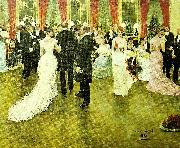 |
j. beraud -- Click Here
|
|
1849-1935
1849 - Saint Petersburg, Russia - 1935 Paris)
Scenes of daily life painted by Jean Beraud reveal interest in Naturalism. Such diverse themes as crowds observing the funeral of Victor Hugo (see Carnavalet, Paris) or studies of the interior of a Parisian Bank Apartment reflect aspects of French society during the Third Republic. |
|
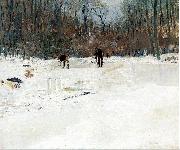 |
J. Alden Weir -- Click Here
|
|
(August 30, 1852 - December 8, 1919) was an American impressionist painter and member of the Cos Cob Art Colony near Greenwich, Connecticut. Weir was also one of the founding members of "The Ten", a loosely-allied group of American artists dissatisfied with professional art organizations, who banded together in 1898 to exhibit their works as a stylistically unified group.
|
|
|
|
 |
J B Armand Guillaumin -- Click Here
|
|
1841-1927
Born Jean-Baptiste Armand Guillaumin in Paris, France, he worked at his uncle's lingerie shop while attending evening drawing lessons. He also worked for a French government railway before studying at the Academie Suisse in 1861. There, he met Paul C??zanne and Camille Pissarro with whom maintained lifelong friendships. While he never achieved the stature of these two, his influence on their work was significant. C??zanne attempted his first etching based on Guillaumin paintings of barges on the River Seine.
Guillaumin exhibited at the Salon des Refus??s in 1863 and later became a friend of Vincent van Gogh whose brother, Theo sold some of his works.
Noted for his intense colors, major museums around the world display Guillaumin's art. He is best remembered for his landscapes of Paris, the Creuse departement, and the area around Les Adrets-de-l'Esterel near the Mediterraneran coast in the Provence-Alpes-Cote d'Azur region of France.
Armand Guillaumin died in 1927 in Orly, Val-de-Marne just south of Paris. |
|
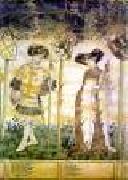 |
IVERNY, Jacques -- Click Here
|
|
French painter (active about 1411-1435) |
|
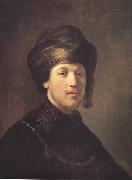 |
Isack jouderville -- Click Here
|
|
c,1612-before 1648
Dutch painter. His father, who came from Metz, kept a popular inn at Leiden. Isack Jouderville was among Rembrandt's earliest pupils and was apprenticed to the artist from late 1629 until the end of 1631. for the payment of his apprenticeship fees, signed by Rembrandt. During his last year of apprenticeship, Jouderville went to Amsterdam with Rembrandt. In 1632 he enrolled as a student of philosophy at Leiden University; it may well be, however, that he stayed in Amsterdam to assist Rembrandt in his workshop with his numerous portrait commissions. Jouderville himself painted mainly Rembrandtesque heads or 'tronies' and was such a faithful follower of his master's early work that several of his paintings were at one time attributed to Rembrandt. In 1636 Jouderville married Maria Le Fevre and settled in Leiden. Between 1641 and 1643 he lived in Deventer, after which he moved to Amsterdam, where he was last recorded in 1645. |
|
 |
Inigo Jones -- Click Here
|
|
English Baroque Era Architect, 1573-1652,Masque designer, architect, and courtier, Jones's architectural legacy only fructified in the early 18th cent. through the neo-Palladian movement. Yet Jones personally remains frustratingly elusive, for all his arrogance and engrossing power as surveyor of the king's works (1615-44). Apart from entrancing scenic and costume designs, only seven of Jones's 45 architectural works survive: the most notable are the Whitehall Banqueting House, Queen's chapel at St James's, Queen's House at Greenwich, and, by no means least because of its Carolean town-planning context, St Paul's church, Covent Garden. |
|
|
|
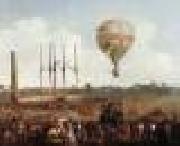 |
IBBETSON, Julius Caesar -- Click Here
|
|
English Painter, 1759-1817
English painter, printmaker and writer. The son of a clothier, he was apprenticed to John Fletcher, a ship painter in Hull; in 1775 Ibbetson became a scene-painter there. In 1777 he moved to London, where he worked as a scene-painter and picture restorer. He married about three years later. From 1785 he exhibited landscapes, genre scenes and portraits at the Royal Academy. In 1787-8 Ibbetson was personal draughtsman to Col. Charles Cathcart on the first British Mission to Beijing, a voyage that included visits to Madeira, the Cape of Good Hope and Java. His watercolour False Bay, Cape of Good Hope (London, V&A), made on this journey, shows a picturesque roughness of foliage and rustic staffage adapted from his English landscape style. Cathcart's death forced Ibbetson to return to England (he exhibited an oil painting, untraced, of the Burial of Col. Cathcart in Java at the Royal Academy in 1789); thereafter he lived by painting landscape oils and watercolours, the subjects culled from his frequent tours. He painted occasional portraits throughout his career (e.g. Young Man, 1790; Leeds, Temple Newsam House) and contributed to John Boydell's Shakespeare Gallery (e.g. Scene from 'The Taming of the Shrew', untraced, see Waterhouse, p. 192). In 1789 he stayed with John Stuart, 3rd Earl of Bute, at Cardiff Castle and visited the Isle of Wight in 1790. In 1792 he toured Wales and the surrounding area with the painter John 'Warwick' Smith and his companion Robert Fulke Greville, resulting in the publication of his book of engravings, A Picturesque Guide (1793). His oil painting of Aberglasyn: The Flash of Lightning (Leeds, C.A.G.) evokes the sublimity of the mountainous Welsh terrain; the drama of the storm over Aberglasyn is conveyed by thick impasto and strong chiaroscuro, a way of handling paint that Ibbetson learnt from copying 17th-century Dutch masters while working for a London dealer named Clarke during the late 1770s and early 1780s. |
|
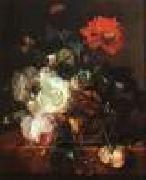 |
HUYSUM, Jan van -- Click Here
|
|
Dutch Painter, 1682-1749
Dutch painter of still life and landscapes. His father was Justus van Huysum (1659?C1716), a successful landscape and genre painter of Amsterdam. Although he painted landscapes in a classical style, Jan is best known for his flower and fruit still lifes in oil and in watercolor. These are distinguished for their brilliant light and shade effects, delicacy of coloring, and exquisite finish. They are to be found in most of the leading European museums |
|
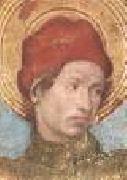 |
HUGUET, Jaume -- Click Here
|
|
Spanish Early Renaissance Painter, ca.1415-1492
Spanish painter. He is thought to have spent time in Saragossa in his youth (c. 1435-45), and he subsequently worked in Tarragona before establishing himself in Barcelona in 1448. He must, however, have had contact with painting from Barcelona before he moved there, because the centre panel of an early retable dedicated to the Virgin (Barcelona, Mus. A. Catalunya) from Vallmoll, near Tarragona, shows his awareness of the style of Bernat Martorell in the profiles of the two foreground angels, and of Llu?s Dalmau's Virgin of the Councillors (Barcelona, Mus. A. Catalunya) in the illusionistic painting of the Virgin's jewel-trimmed garments. In other early works, such as the Annunciation and Crucifixion from a small retable (Vic, Mus. Episc.), |
|
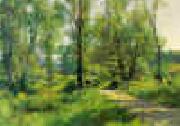 |
Hugh Bolton Jones -- Click Here
|
|
American Painter, 1848-1927 |
|
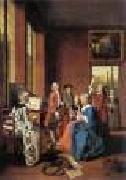 |
HOREMANS, Jan Jozef II -- Click Here
|
|
Flemish painter (b. 1714, Antwerpen, d. after 1790, Antwerpen) |
|
|